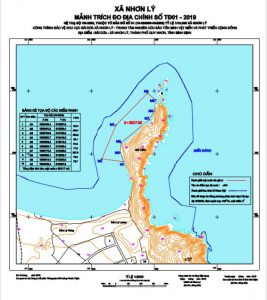News and events
Learning from Experience
The fishing industry in south-central vietnam relies on co-management and the ecosystem based approach to fisheries management (EAFM) to sustain the health of coastal marine areas.
Vietnam’s 3,260-km coastline hosts a diversity of marine resources such as coral reefs and seagrass beds as well as more than 1,080 species of fish. The health of Vietnam’s coastal and marine ecosystems is fundamental to the food security, livelihoods and social stability of more than 4 mn Vietnamese people who directly or indirectly benefit from the exploitation of marine resources.
Small-scale fisheries are abundant in Binh Dinh, located in the southcentral coast of Vietnam, making up nearly 40 per cent of the country’s small-scale fishing fleet. Fishing is a common source of livelihood and income generation at the household level.
The health of Vietnam’s marine and coastal ecosystems and, therefore, the sustainability of Vietnam’s fishing industry, is compromised by illegal, unreported and unregulated (IUU) fishing activities. They include overfishing and destructive methods like trawling and the use of explosives. These prevalent illegal practices destroy and deplete near-shore aquatic resources. The negative effects of over exploitation are visible. For example, fishermen’s earnings from fishing activities are at times not enough to cover costs. These challenges are intensified by weak enforcement of the Fisheries Law of 2017 and other regulations that prohibit IUU fishing.
National and international organizations are currently using co-management and an ecosystem-based approach to fisheries management (EAFM) to reduce the decline of coastal marine resources in Vietnam. They encourage sustainable development, protect the interests and rights of local communities and work toward removal of the ‘yellow card’ assigned by the European Commission.
Under the governance system called co-management, control over resources in a specified geographic area is shared between the state and community. It is part of the EAFM approach that integrates a balance of ecological well-being, human well-being and good governance into decision making processes. EAFM helps valuable resources to replenish by protecting ecosystem stability and maximising ecological and social benefits in fishing areas. For this reason, EAFM has become common practice throughout Southeast Asia.
While fairly new in Vietnam, the national government supports the use of EAFM by agreeing to the Code of Conduct for Responsible Fisheries (CCRF) mooted by the Food and Agriculture Organization of the United Nations (FAO). Policies, legislation, and practical experience with EAFM remain limited in Vietnam, but the practice is gradually being implemented at the local level.
Co-management and EAFM have been priorities for Vietnam’s Ministry of Agriculture and Rural Development (MARD) since the Fisheries Law 2017 and Decree No. 26/2019/ND-CP came into effect on January 1, 2019, and April 25, 2019, respectively. The revised law formally defines the concept of co-management, while Article 10 of the decree provides guidelines for implementing the law and regulations for co-management in the protection of fishery resources. The institutionalization of comanagement through the highest form of legal documentation is a significant achievement.
Figure 1: Map of Bai Dua Beach in Nhon Ly commune, Quy nhon LMMA, Binh Dinh
The goals of Vietnam’s Fisheries Law 2017 greatly align with the Voluntary Guidelines for Securing Sustainable Small-Scale Fisheries in the Context of Food Security and Poverty Eradication (SSF Guidelines). These Guidelines are implemented in Vietnam by the Center for Marinelife Conservation and Community Development (MCD), with the support of the International Collective in Support of Fishworkers (ICSF). The SSF Guidelines are realized through improved policies, strategies and initiatives, such as those in Bai Dua, Nhon Ly, Quy Nhon Locally Managed Marine Area (LMMA).
Co-management-in-law, EAFM in action ‘Enhancing resilience of small-scale fishing communities and marine ecosystems in Locally Managed Marine Areas (LMMA) in the South Central Coast of Vietnam’, is the tile of the project implemented by MCD with the support of Hong Kong-based ADM Capital Foundation. It aims to strengthen institutional capacity, practice and policy development in coastal areas in South Central Vietnam by improving local capacity and experience with EAFM practices. Active from early 2017 through March 2020, this project intends to use EAFM to enhance the resilience of ecosystems and local communities, creating a model that could be used throughout the country. For instance, an EAFM plan for 2016- 2020 was developed for the Quy Nhon LMMA in Binh Dinh province in the southcentral part of the country. Managed by Nhon Ly, Nhon Hai, Nhon Chau and Ghenh Reng communities, LMMA is home to a rich diversity of endemic species, including the orange-spotted grouper and the black sea cucumber, as well as 88 ha of coral reef, about 81 per cent of the coral reef in Binh Dinh’s coastal area. The plan looks to reduce illegal fishing, protect important habitats, restore economically valuable fish populations, improve livelihoods, engage local communities in management and prevent overfishing, among other objectives.
For more detailed information : https://www.icsf.net/images/samudra/pdf/english/issue_82/276_ICSF_Samudra%2082_February_2020.pdf (Page 39-42)
Read more
- MCD participated in the Kickoff Workshop of MARE Program in Bremen
- Memorandum of Understanding (MoU) to build public private collaboration towards circular economy in plastic waste management
- Consultation Workshop: “Assessment Report on Vessel Tracking Analysis and Technology Solutions of Electronic Catch Documentation and Traceability (eCDT) Systems in Vietnam”



























